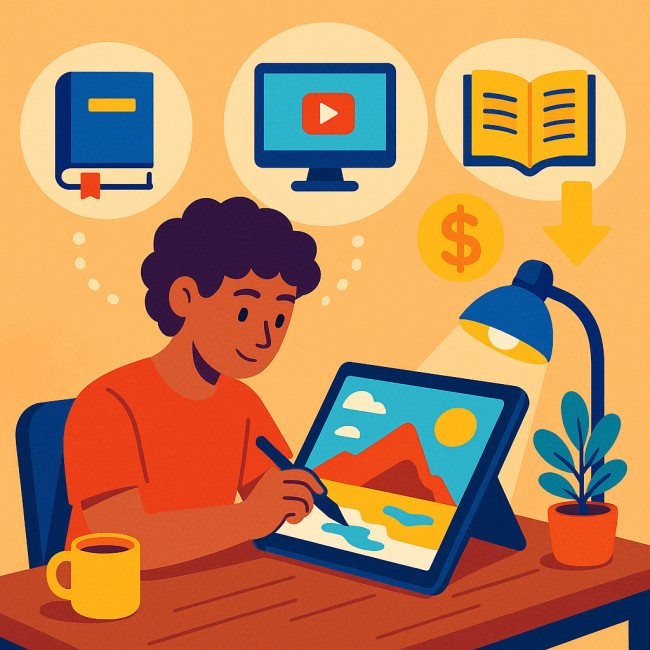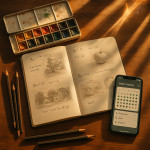Curated learning routes to master digital painting without pricey subscriptions
Monthly fees can chip away at your budget long before your brushwork shines. This guide shows you step-by-step learning routes that sharpen digital painting skills for a fraction of a single streaming bill—no recurring subscriptions, no FOMO, just focused progress.
Why curated learning beats endless subscriptions

Imagine a young illustrator hunched over a tablet, daylight spilling across a modest studio while translucent comparison charts hover in holographic space above the screen. Books, clipped video thumbnails and miniature price tags orbit the composition to underline how one carefully mapped syllabus can eclipse endless auto-renew buttons. The visual narrative conveys momentum, deliberate focus and the quiet satisfaction of building mastery without draining a wallet—reinforcing the article's promise that curated learning can outperform pricey subscriptions for less than the cost of a weekly latte.
Cost-benefit snapshot
Source : Official platform price pages
Most platforms require $10–$20 every month. A curated route mixes one-off purchases, free archives and peer critique. Our sample plan averages just $2.50 per month over a year—proof that intention trumps infinite choice.
Five learning routes that cost less than a coffee per week
- Public library e-books
Request best-selling digital art titles through the Libby or OverDrive apps. The waitlist grants you natural study breaks. - One-off masterclasses on sale
Bookmark upcoming discount windows on Udemy and Domestika. Grab a fundamentals course at –80 % and revisit for life. - Free software tutorials plus sample files
Clip Studio Paint and Krita both publish workflow articles with downloadable brushes. Follow along, then tweak settings until the stroke feels like yours. - Open-access conference talks
IMAGINE FX, Lightbox Expo and GDC upload full sessions after the event. Build a playlist that matches your current hurdle—be it colour harmony or rendering metals. - Peer-led critique circles
Join a Discord channel with weekly paint-overs. The format is free and feedback arrives faster than any paid mentor review.
Combine two items from the list and you already cover theory and critique. Add a third source for practice prompts and your pipeline is complete—all without a single auto-renew tick box.
Assemble your personalised syllabus in 30 minutes
Step-by-step checklist
- Define one skill gap per month: anatomy, light, mood, etc.
- Search three learning media for that topic: book, video, live stream replay.
- Filter for ≤ 4 h duration; long courses stall momentum.
- Bookmark deliverables: exercise files, homework prompts, PDF notes.
- Schedule two review sessions to revisit finished pieces and measure growth.
The result? A living syllabus tied to outcomes, not hours watched. For portfolio polish techniques, scan the actionable tips inside our digital artist online portfolio checklist.
Keep momentum: accountability & community tactics
Learning in a vacuum kills consistency. Add human touchpoints to stay on track.
Weekly micro-goals
Post one WIP shot every Wednesday. Tag #DigitalPaintProgress on social channels for instant peer support.
Monthly skill swaps
Pair with a friend who loves an area you dodge. You teach lighting, they teach colour. This low-cost barter fires dopamine without draining wallets.
Quarterly challenge
Enter a prompt-based event such as Artvertiser training hub sprints. Deadlines cement habits and expose your work to recruiters scouting fresh styles.
Portfolio-ready in 90 days: milestone roadmap
| Week | Focus | Output | Audit question |
|---|---|---|---|
| 1–2 | Brush control & line economy | 30 gesture sketches | Do lines taper naturally? |
| 3–4 | Greyscale values | 3 still-life studies | Is form readable without colour? |
| 5–6 | Colour theory basics | Palette swatch sheet | Are complements balanced? |
| 7–8 | Material rendering | Metal, wood, skin spheres | Does texture look tactile? |
| 9–10 | Environment depth | One fully lit scene | Is atmospheric perspective clear? |
| 11–12 | Character composite | Hero illustration | Would this fit in a client brief? |
Need advanced colour tips for week 5? Dive into hands-on colour theory workouts. Struggling with believable surfaces? Our texture clinic adds depth without extra software.
Bonus resources for texture, colour and critique
- Texture brush packs from Krita Artists forum—free and open-source.
- Flat-to-finish videos on artist YouTube channels such as Marc Brunet and Sam Does Art.
- Daily sketching logs—learn how to structure them in this sketching log tutorial.
Ready to drop subscriptions? Take the quiz
FAQ
- Can I become industry-ready without any paid courses?
- Yes. Free content plus disciplined practice can cover foundations. Invest selectively in critique or niche workshops when plateaus appear.
- Which software is best for budget learners?
- Krita and Autodesk SketchBook are free. If you own an iPad, Procreate's one-time fee offers advanced brushes under $15.
- How do I track progress without a tutor?
- Set measurable goals, archive WIP files, and schedule monthly self-reviews. Compare older layers against new ones to confirm improvement.
- What if I miss structured feedback?
- Join weekly paint-over servers or subreddit critique threads. Many professionals volunteer helpful notes, no payment required.
- How soon should I build a portfolio?
- Begin after 8–10 finished pieces that align stylistically. Continuous refinement beats waiting for perfection.
Take action now
Grab one free tutorial, sketch for 30 minutes tonight, and post your result in a peer circle. You will save money and gain clarity faster than any auto-renew notification can deliver.











